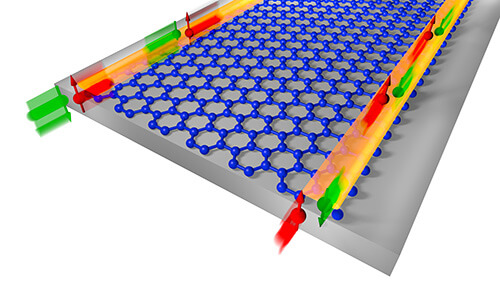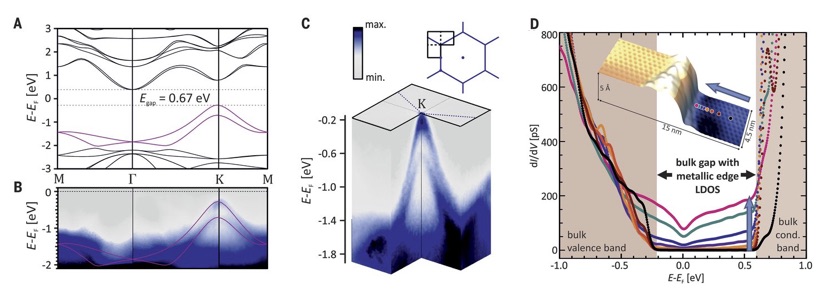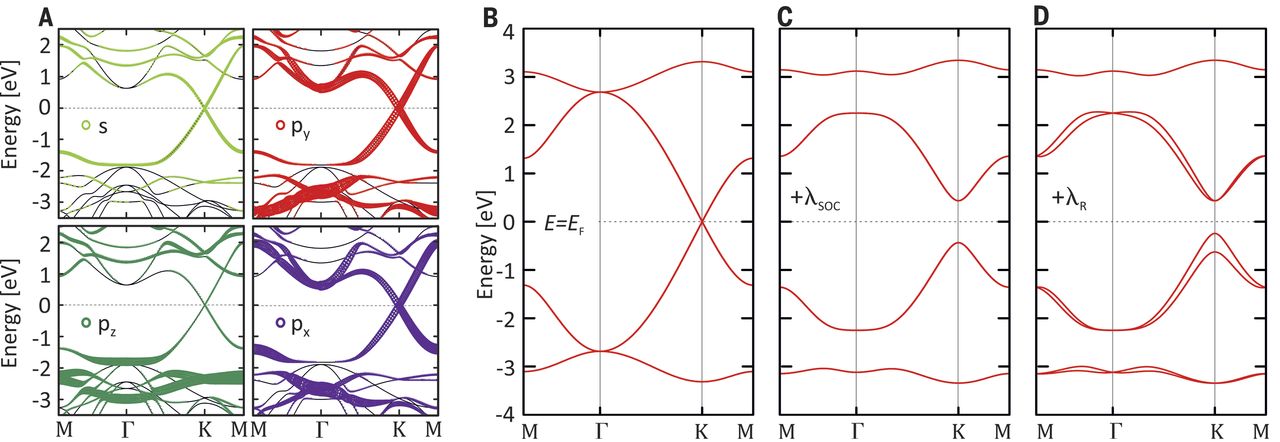In condensed-matter physics, the states of matter are classified conventionally as metal, insulator, and semiconductor. A new field has emerged in the last few years which leads to the discovery of a new quantum phase of matter – topological insulators (TIs). A topological insulator, like a conventional insulator, has a bulk energy gap separating the highest occupied electronic band from the lowest unoccupied band. But remarkably at the surfaces/edges there exist conducting channels due to quantum effects. The conductive conduits prevent spin scattering which promises the highly efficient transmission of information virtually without loss. These materials, therefore, could be perfect for spintronic applications. However, their operating temperature was far below room-temperature due to the small bulk gap size (~30meV), which seriously hindered their applications in the field of spintronics.

Fig. 1: (Schematic figure) Conducting edge channels at the boundaries of the bismuthene film.
Recently, a joint research group from Würzburg University, Germany and ShanghaiTech University, China has made a breakthrough in searching for large-gap TIs at two-dimension, which is also known as quantum spin Hall insulators. The successful growth of 2/3-monolayer Bi on SiC(0001) substrate in form of honeycomb structure realizes quantum spin Hall effect with a topological gap of 0.8 eV, which provides a perfect material platform for spintronic applications. The results are summarized in a report entitled “Bismuthene on a SiC substrate: A candidate for a high-temperature quantum spin Hall material”, which is published online in Science on July 21, 2017. Assistant Professor Gang Li from the division of condensed matter physics and photon science (DCPS) at ShanghaiTech University’s School of Physical Science and Technology (SPST) is the co-first author, by whom all calculations and most of the theoretical analysis are carried out.
This work is another achievement of ShanghaiTech in condensed-matter physics after the discovery of “chiral Majorana fermion modes in a quantum anomalous Hall insulator – superconductor structure” (http://science.sciencemag.org/content/357/6348/294) reported at July 21 2017.

Fig. 2: (A) The theoretically predicted valence band splitting and the 1-dimensional edge states were nicely observed experimentally in (B, C) ARPES and (D) STM.
In this work, scientists from the joint research group have successfully prepared high-quality monolayer Bi film strained by SiC substrate. The splitting of the top valence band observed in angle-resolved photoemission (ARPES), as well as the quantum states residing at the 1-dimensional edge observed in scanning tunneling spectroscopy (STM) highly agree with the theoretical predictions. One highlight of this work is the adoption of an insulating substrate, which promises a clear separation of the topological edge states from the bulk states. It provides a clean working condition for the manipulation of edge spins in spintronics. Another highlight of the work is that researchers successfully revealed the profound reason for the large topological gap of the system after a careful analysis of the electronic structure. Crucially different from its cousin graphene, the energy bands of Bismuthene around the Fermi level mainly consist of Bi-px and Bi-py orbitals, for which the onsite term (being the largest contribution) of the spin-orbit coupling (SOC) is nonzero. In tandem with the large atomic number of Bi, the topological gap is conspicuously larger than any experimentally known topological system.

Fig. 3: (A) The Fermi surface of bismuthene consist mainly of Bi-px and Bi-py orbitals, based on which an effective model can nicely explain (B) the Dirac linear band crossing in the presence of no SOC; (C) the large topological gap induced by the onsite SOC; (D) and the valence band splitting caused by the Rashba term.
This work is a breakthrough in searching for large-gap quantum spin Hall materials. It is of both scientific and practical significance because it raises the operating temperature to far above room temperature and it also provides guiding principle for the future search for and design of large-gap quantum spin Hall materials. The studies in the field of spintronics can advance much faster since supercooling is no longer required to the quantum effects within the conductive channels, which may also stimulate revolutionary progress in quantum computation.


